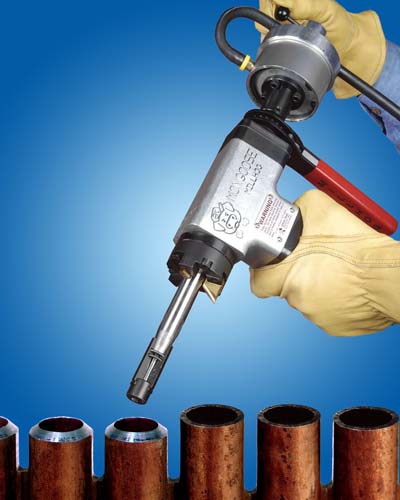
An air-powered clamp that speeds attachment to the tube I.D. and releases the clamp ribs instantly after milling, to set up faster and help reduce operator fatigue, is available from ESCO Tool.
The MILLHOG Mongoose Air Clamp End Prep Tool features power assisted clamping for instant attach and release to the tube or pipe I.D. which speeds set up and reduces operator fatigue. Developed for repetitive end preps on tubes from ½" I.D. to 3" O.D., this end prep tool is ideal for use on boiler panels in limited access areas and in fabrication shops.
Eliminating the need for manual clamping, especially in physically demanding environments, the MILLHOG Mongoose Air Clamp End Prep Tool rigidly mounts to the tube I.D. and can increase productivity by up to 600 percent, claims the firm. Because the clamp ribs retract off the mandrel automatically, there is less friction which promotes higher reliability and longer wear.
The MILLHOG Mongoose Air Clamp End Prep Tool is priced from $4,995.00 and can be rented in the continental U.S.A. for $168.00 per week.
Contact Details
Related Glossary Terms
- fatigue
fatigue
Phenomenon leading to fracture under repeated or fluctuating stresses having a maximum value less than the tensile strength of the material. Fatigue fractures are progressive, beginning as minute cracks that grow under the action of the fluctuating stress.
- gang cutting ( milling)
gang cutting ( milling)
Machining with several cutters mounted on a single arbor, generally for simultaneous cutting.
- mandrel
mandrel
Workholder for turning that fits inside hollow workpieces. Types available include expanding, pin and threaded.
- milling
milling
Machining operation in which metal or other material is removed by applying power to a rotating cutter. In vertical milling, the cutting tool is mounted vertically on the spindle. In horizontal milling, the cutting tool is mounted horizontally, either directly on the spindle or on an arbor. Horizontal milling is further broken down into conventional milling, where the cutter rotates opposite the direction of feed, or “up” into the workpiece; and climb milling, where the cutter rotates in the direction of feed, or “down” into the workpiece. Milling operations include plane or surface milling, endmilling, facemilling, angle milling, form milling and profiling.








